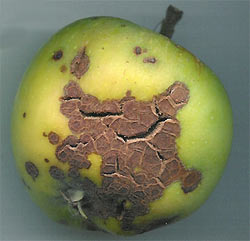(SOURCE: NCBI database)
KINGDOM: Fungi
DIVISION: Ascomycota
CLASS: Dothideomycetes
ORDER: Pleosporales
FAMILY: Venturiaceae
GENUS: Venturia
SPECIES: inaequalis

Apple scab spends winter among fallen, infected leaves on the ground, in the state of immature pseudothecia. Spores of the ascospore kind are sexually produced within the pseudotecia. In the spring when rains come, the pseudothecia expand when wet, and suddenly discharge the enclosed spores, dispersing them.
Having found its summer host -- the apple tree -- the newly arrived spore produces a fungal hypha which penetrates into the host tissue. At some point the hyphae asexually produce a new kind of spore, collectively called conidia. The infected tissue then becomes covered with brown to olive-brown lesions covered with more conidia. The apple in the picture shows the disease's typical cracks in a brown "scab." Once the conidia mature they are blown or otherwise spread to new tissue and can cause a new infection cycle before the growing season ends.
The asexually produced conidia in the winter leaf litter occur in different strains, suggestive of male and female types, but different. When mutually receptive hyphae of different strains meet, they can produce pseudothecia, from which the coming season's sexually produced ascospores may be discharged, starting the cycle over again.